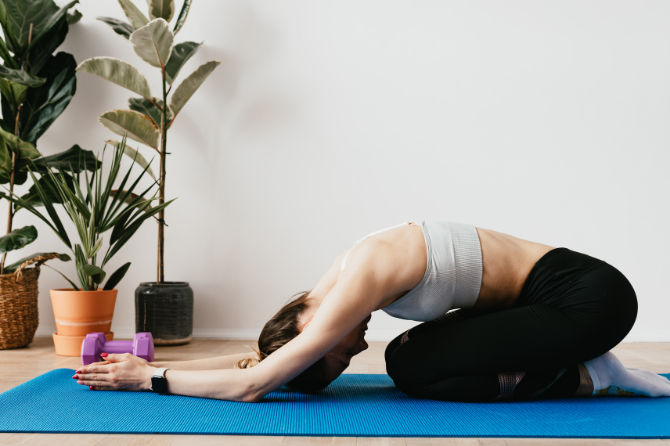
As we dive into the significance of stretching, it’s the perfect time to explore this often overlooked practice in our daily lives. This blog is dedicated to promoting the importance of stretching for our overall well-being. Stretching is not merely a prelude to a workout or just for athletes and gym enthusiasts; it is a practice that benefits individuals of all ages and lifestyles and is a crucial component of maintaining flexibility, preventing injuries, and promoting overall well-being. In this blog, we’ll explore the importance of stretching, explore the rules and considerations for effective stretching, and discuss both its advantages and potential pitfalls.
Why is Stretching Important?
Stretching goes beyond the physical motions; it’s a fundamental aspect of maintaining a healthy lifestyle. It enhances flexibility, increases range of motion, and contributes to improved posture. Beyond the physical benefits, stretching also plays a pivotal role in stress reduction by providing a moment of tranquility in our busy lives.
Stretching is an essential component of any well-rounded fitness routine. Its benefits extend far beyond simply increasing flexibility. Here are some key reasons why stretching is important:
- Improved Flexibility and Range of Motion
- Enhanced Performance
- Reduced Muscle Tension
- Improved Posture
- Increased Blood Circulation
- Stress Relief
The Rule for Stretching: Striking the Right Balance
Understanding the rules of stretching is essential to reap its full benefits. To make the most out of your stretching routine, it’s important to follow some fundamental rules. Here are some key guidelines to keep in mind:
- Warm-Up before Stretching
- Stretch All Major Muscle Groups
- Hold Each Stretch for an Adequate Duration
- Breathe and Relax
- Stretch to the Point of Mild Discomfort, Not Pain
- Incorporate Both Static and Dynamic Stretching
Remember, everyone’s body is different, so it’s important to adjust your stretching routine to suit your individual needs and limitations. Consult with a healthcare professional or a certified fitness trainer for personalized guidance and recommendations.
Considerations When Stretching: Mindful Movements
While engaging in stretching exercises, it’s crucial to be considerate of your body’s signals. There are several important factors to consider to ensure safety and effectiveness. We’ll explore the importance of mindful movements, listening to your body, and recognizing when to push boundaries and when to exercise caution.
- Proper Form and Technique
- Alignment
- Controlled Movements
- Focus on the Target Muscle
- Avoid Overstretching
- Balance and Symmetry
- Listen to Your Body
By being mindful of these considerations and practicing proper form and technique, you can make your stretching routine safer and more effective.
What Not to Do: Common Mistakes in Stretching
Avoiding certain practices during stretching is as important as incorporating the right ones. We’ll highlight common mistakes, such as bouncing during stretches and overstretching, and discuss why steering clear of these pitfalls is essential for injury prevention.
While stretching can provide numerous benefits, it’s important to be aware of what not to do to avoid potential risks and injuries. Here are some things to avoid when stretching:
- Bouncing or Ballistic Movements
- Holding Your Breath
- Stretching Cold Muscles
- Ignoring Pain
- Neglecting Balance
- Overstretching
By avoiding these common mistakes, you can ensure a safe and effective stretching routine that maximizes the benefits for your body.
Advantages of Stretching: Beyond the Flexibility Factor
Stretching offers a myriad of advantages beyond increased flexibility. From improved circulation to enhanced muscle coordination, we’ll delve into the diverse benefits that make stretching an indispensable part of any fitness routine.
Stretching offers several advantages for the body, including:
- Improved flexibility
- Injury prevention
- Increased blood flow
- Reduced muscle soreness
- Enhanced athletic performance
- Stress relief
It is important to note that stretching should be done correctly and safely to maximize its benefits. Avoid bouncing during stretches, stretch within your comfort level, and consult a doctor or physical therapist if you have any physical limitations that may affect your stretching routine.
Disadvantages of Stretching: When Too Much Becomes Detrimental
While stretching is generally beneficial, it’s essential to be aware of potential disadvantages, especially when done incorrectly or excessively. We’ll discuss scenarios where stretching might be counterproductive and how to strike a balance for optimal results.
- Risk of injury
- Weakening of muscles
- No proven benefit for muscle soreness
- Potential for decreased performance
- Risk of overstretching
It’s worth noting that the disadvantages of stretching can vary depending on the individual, the type of stretching, and the specific context. It’s always a good idea to consult with a healthcare professional or a qualified fitness trainer to determine the most suitable stretching routine for your needs and goals.
When to Stretch: Finding the Optimal Time
When it comes to incorporating stretching into your daily routine, the timing can play a significant role in maximizing its benefits. While there isn’t a one-size-fits-all answer, there are a few considerations to keep in mind. Whether it’s a dynamic warm-up before exercise or a relaxing stretch before bedtime, we’ll explore the most opportune times to incorporate stretching into your daily routine.
- Evening Stretching for Relaxation and Sleep
- Pre-Workout Stretching for Warm-Up
- Throughout the Day
- Listen to Your Body
Remember, consistency is key when it comes to stretching. Whether you choose to stretch in the morning, evening, or throughout the day, incorporating regular stretching sessions into your routine can help improve flexibility, prevent injuries, and promote overall well-being.
Conclusion:
Stretching is not just a routine; it’s a lifestyle that contributes to your physical and mental well-being. In this journey, we’ve uncovered the importance of stretching—how it enhances flexibility, improves posture, and serves as a sanctuary for stress relief. Adhering to the rules of stretching, and finding the delicate balance between challenge and caution, ensures you make the most of this fundamental practice.
We’ve navigated through considerations when stretching, emphasizing the need for mindful movements and steering clear of common mistakes that can hinder progress and lead to injuries. Along the way, we’ve explored the numerous advantages of stretching, from increased circulation to enhanced muscle coordination. However, it’s equally vital to acknowledge potential pitfalls, understanding when too much stretching can become detrimental. By recognizing common contraindications and being attentive to your body’s signals, you pave the way for a safe and effective.
Ready to embark on a journey to enhanced flexibility and well-being? Take the first step by scheduling an appointment with OakBend’s Physical Therapists. Call 281-341-2874 or visit our Physical Therapy page and start your path to a healthier, more resilient you!
Leave a reply







